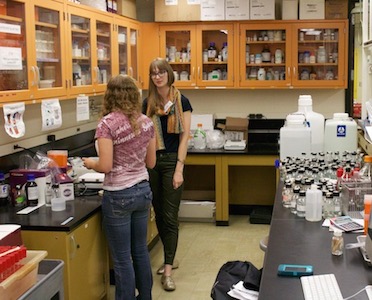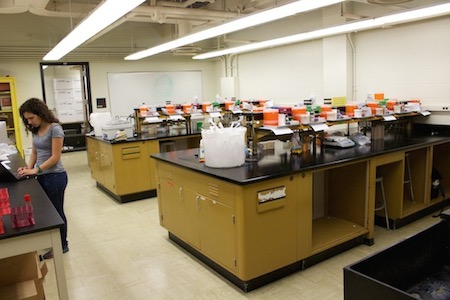The college led the way in adopting the active-learning approach to teaching and learning. Now CBS is setting its sights on the undergraduate research experience with a proposed renovation in the Biological Sciences Center.


Nearly every College of Biological Sciences undergraduate graduates with at least one research experience under their belt. It might take the form of a project in the Foundations of Biologycourse sequence or directed research in a faculty member’s lab. Both come with constraints on subject matter and research model. But what if students could pursue research based on their own interests?
That’s the idea behind a proposed renovation of space in the Biological Sciences Center on the University’s St. Paul campus — part of the University’s Academic and Student Experience Investments project. Current labs, constructed in the 1960s as evidenced by the color scheme — orange, mustard and black — so prevalent in that bygone era are nearly at capacity and limit students’ ability to work independently with lab benches arranged in tight rows and a lack of space for computation, an increasingly central part of biology research.
“Space can work on your behalf or against you — active learning in a lecture hall is almost impossible, for example” says Robin Wright, head of the Department of Biology Teaching and Learning. “But if you have a space where students come in and see that it’s going to be a little different, it makes them more open to put themselves out there and be willing to participate.”
“We want to empower our undergraduates to ask their own questions, design their experiments, come up with their own discoveries,” says Wright, who led the way in introducing the active-learning approach to the college’s classrooms. Now, she wants to apply that award-winning approach to teaching and learning in the lab, as well.
Turning outdated faculty labs into “active-learning labs” where students will be able to choose among very different research experiences based on questions they develop themselves just made sense as a cost-effective way to make the most of existing space. It’s also necessary to keep up with surging enrollment.
“We are committed to ensuring quality research experiences for all our students,” says CBS Dean Valery Forbes. “Renovating space in the Biological Sciences Center will allow us to do something entirely new — let students drive their research experience.”
The proposed lab space will prioritize flexibility and collaboration, creating more opportunities for computational biology and even a little serendipity.
“There’s really nothing like what we are doing here. … I don’t know a single other place saying every student we teach will engage with the full process of science with the potential to discover something new,” says Wright.
Ultimately, Wright believes that giving students more freedom and more responsibility will deepen their interest in the basics of biology.
“Many of our students are focused on making a difference in the world. With active-learning labs, we ask them to take their own interests as a starting point for applying what they know about mitosis, metabolic pathways and other basic concepts,” says Wright. “It helps them see how biology matters in their lives and how they can use it.” – Stephanie Xenos
"There’s really nothing like what we are doing here. … I don’t know a single other place saying every student we teach will engage with the full process of science with the potential to discover something new.” – Robin Wright